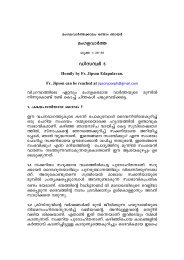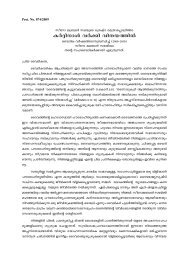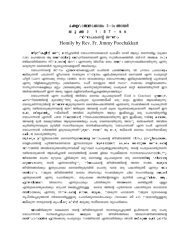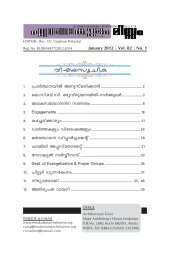THE TRINITARIAN COMMUNION - Archdiocese of Ernakulam ...
THE TRINITARIAN COMMUNION - Archdiocese of Ernakulam ...
THE TRINITARIAN COMMUNION - Archdiocese of Ernakulam ...
Create successful ePaper yourself
Turn your PDF publications into a flip-book with our unique Google optimized e-Paper software.
future one. It is present because our fellowship with the son begins now and growsand it comes to its complete consummation in the future i.e., in the Parousia. Paulincorporates this fellowship with our participation in the Lord’s Supper (1Cor10:16ff), where we have fellowship with the body and blood <strong>of</strong> Christ and with ourfellow human beings. Christian fellowship necessarily leads to communion with otherChristians, to the mutual fellowship <strong>of</strong> members <strong>of</strong> the community. This gives us agood basis for understanding how God enters into our interpersonal relationshipsthrough Jesus Christ, and perfects our interpersonal relationships.We proceed to the understanding <strong>of</strong> Communion in Vatican II and other ecclesiasticalpost – conciliar documents. In these documents too we find the Church’s emphasis onhuman beings relationship with God and among human beings’ themselves, and alsoamong the Christian communities themselves.3.3.3 Understanding <strong>of</strong> Communion in the Church DocumentsCommunion is an essential aspect that we find in Vatican II documents,without which it is difficult to understand Vatican II documents. As K.McDonnellsays, “Koinonia is the central theme <strong>of</strong> Vatican II and already much has been writtenon this. It is impossible to speak <strong>of</strong> any ecclesiological theme without connecting itwith the aspect <strong>of</strong> koinonia. It is an integral, all-pervading and multivalent category inthe documents <strong>of</strong> Vatican II.” 111There is a clear shift in Vatican II’s understanding <strong>of</strong> the Church which movesfrom the institutional, juridical and hierarchical aspect to the communion aspect. AsAvery Dulles says, “Instead <strong>of</strong> a mere universalistic, western, papal, sacral, hierarchic,monolithic, polemic and juridical ecclesiology, Vatican II brings out the revolutionarynotion <strong>of</strong> the Church as communion.” 112 We find the same understanding in NihalAbeyasingha, who says, “the Church opted to describe herself as ‘a kind <strong>of</strong> sacramentor sign <strong>of</strong> intimate union with God and <strong>of</strong> the unity <strong>of</strong> all humankind’ (LG 1). Thisoption marked a definite shift from a juridical ecclesiology to an ecclesiology <strong>of</strong>communion…Thus the institutional and the juridical would be at the service <strong>of</strong> thevital and contribute towards growth and communion.” 113 He proceeds from this option<strong>of</strong> Vatican II to explain the tw<strong>of</strong>old dimensions <strong>of</strong> the Church envisaged in Vatican IIas vertical and horizontal. He says, “The communion envisaged by Vatican II has
















